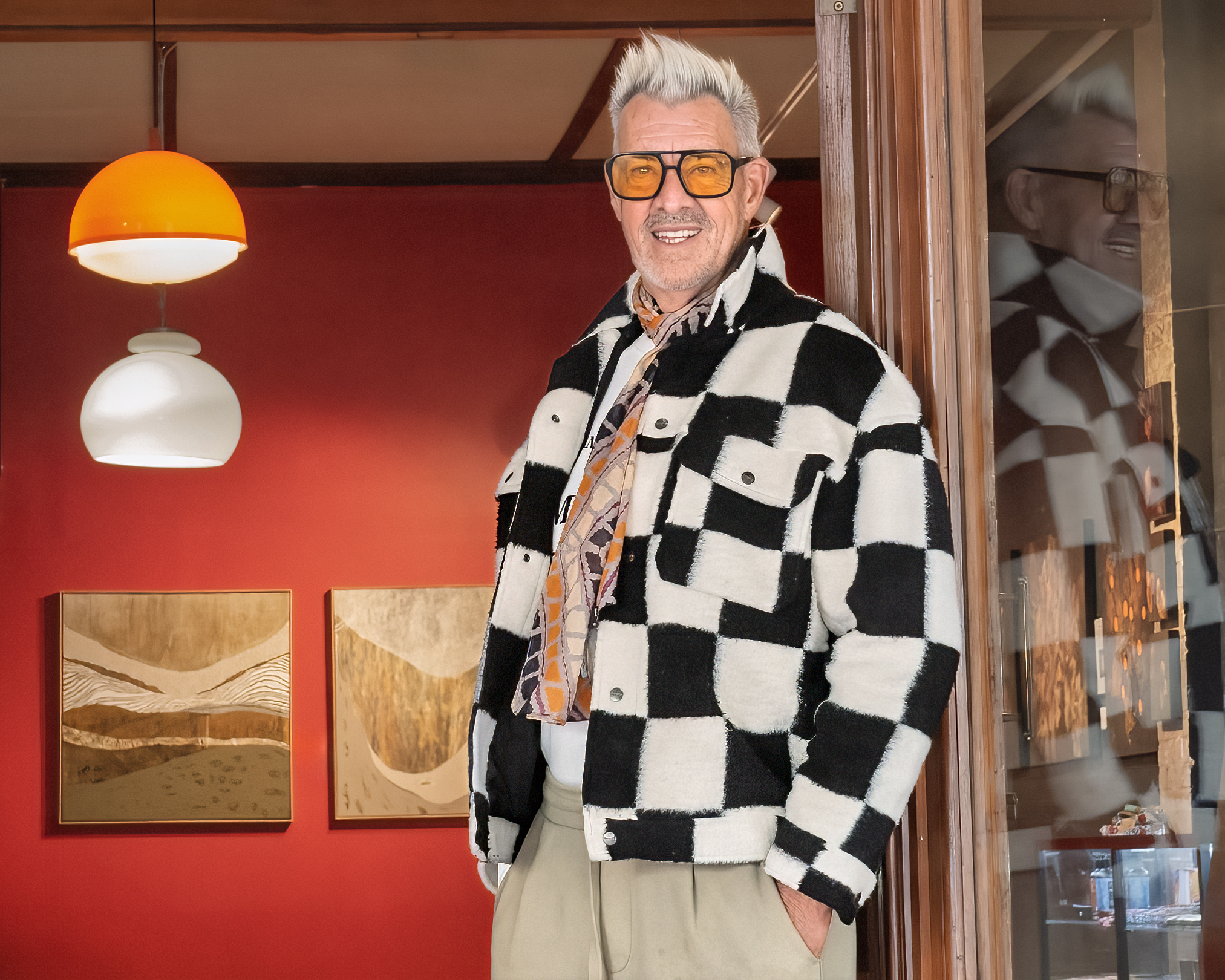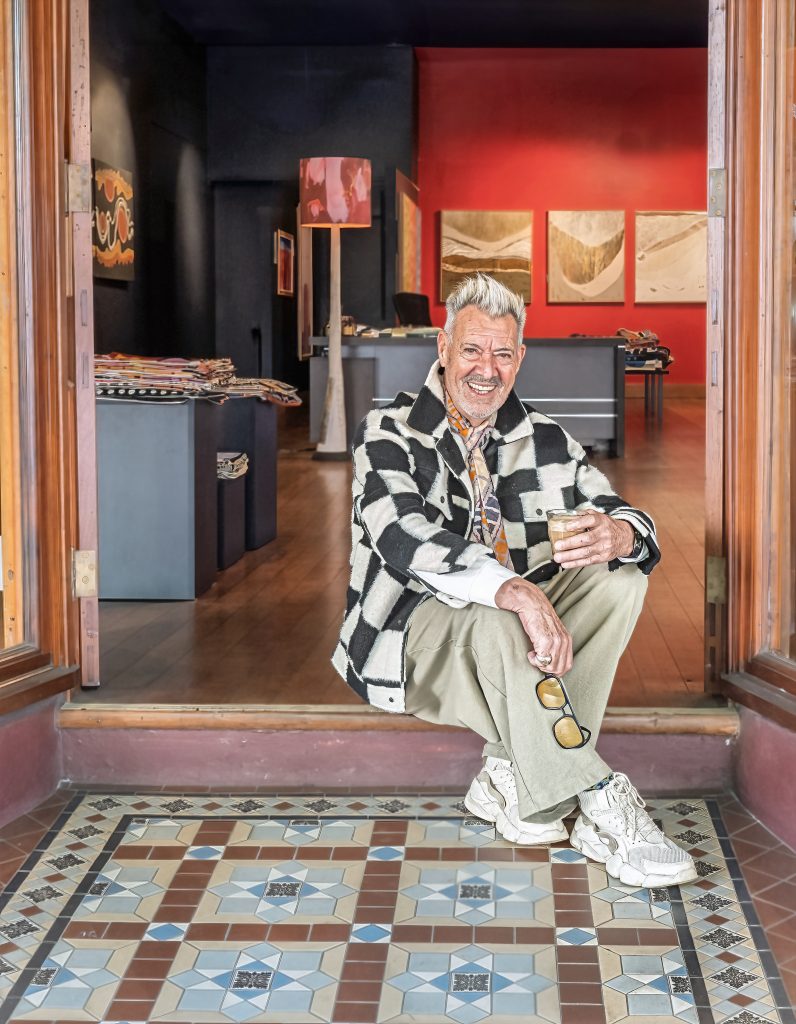
Few towns are lucky enough to have a local shopfront displaying works by artists represented in major public collections across the world, but that’s exactly the enviable position we Bangalowians have been in for nearly eight years now, thanks to Grant Rasheed and his gallery, Ninbella.
It was during a 2017 holiday at a friend’s Myocum farm that the pieces unexpectedly began falling into place for Grant Rasheed’s new chapter in the Northern Rivers. The spontaneity and financial risk may have deterred some, but Grant isn’t one to shy away from a bold new adventure.
It’s in the blood, after all. The original Australian Rasheed, Grant’s grandfather, left his parents in Lebanon as a six-year-old and migrated to Australia with two of his uncles in the 1890s. Arriving in South Australia’s Port Pirie, the Rasheeds settled in the Flinders Ranges, where they went on to own several sheep stations, before the Depression undid much of their hard-earned success.
The Rasheeds were Druze – a small, ancient religious and ethnic community whose highly secretive faith blends elements of Islam, Greek philosophy, Hinduism, and mysticism. Set adrift from their brethren, they joined the ranks of Catholicism, and their numbers swelled – Grant, one of nine children, and uncle to 57 nieces and nephews.
After finishing school, he left the family sheep farm at Orroroo for the bright lights of Alice Springs/Mparntwe, and spent four years stifled amidst the regimented world of bank telling and car rentals, before venturing on to Adelaide where he found a better fit in fashion.

With Europe calling, Grant departed Australia in the early 1980s at the age of 23. An earlier brush with one of King Charles’ best mates who had visited Grant’s uncle’s Wilpena Pound/Ikara property forged an unlikely connection to English aristocracy, and he arrived in London with one phone number in his pocket – that of the fabulously intrepid, mountain-climbing Dowager Duchess of Westminster. His hard yards in hospitality were soon punctuated by semi-regular, surreal trips to her verdant estate for weekend soirées full of fascinating people, ferried to and from the train station by the septuagenarian tearing through the hedgerow-lined country lanes in her old Land Rover like a “bat out of hell”.
Falling in love with an Italian fashion designer provided the perfect excuse to head to Milan, where the two developed their own knitwear label. When the relationship ended 22 years later, Grant returned to the wide-open spaces of the Flinders and landed a job managing the Prairie Hotel in Parachilna – a tiny outpost on the road to Birdsville, population seven.
This historic and quintessentially Australian Outback hotel has evolved into a refined tourist destination since being purchased by its current owners, who tasked Grant with creating an Indigenous art gallery throughout its public spaces.
Grant’s passion for contemporary Indigenous art had been ignited during regular visits to the Art Gallery of South Australia on trips home from Milan, but establishing the Prairie Gallery allowed for complete immersion in the subject.
The Adnyamathanha people of the Flinders are more commonly associated with ancient rock carvings than contemporary painting, and Grant looked further afield for suitable work. Connecting with a dealer from the Northern Territory, he fell in love with the art of the Central Desert region – an area that encompasses renowned communities such as Papunya, Yuendumu, and, ultimately his favourite, Utopia.
Characterised by vibrant colours, intricate patterning, and themes grounded in Country, culture, ceremony, and ancestral knowledge, the artist-led Utopia community has produced some of Australia’s most celebrated artists, including Minnie Pwerle and Emily Kame Kngwarreye.
During his time at the Prairie, Grant launched his own side business exhibiting Indigenous artists in Italy and China. Searching for a suitable name, his niece Carly came across the word “ninbella” in H.M. Cooper’s 1948 book Australian Aboriginal Words – its meaning defined as “beautiful”. With “bella” also meaning beautiful in Italian, the name perfectly embodied Grant’s deep love of both cultures.
Twelve years into his time at the Prairie, Grant came to stay with his friend in Myocum. He noticed the empty shop between Wax Jambu and the pharmacy and enquired about the rent. It seemed like a pipe dream, until the landlord mentioned another gallerist had viewed the space and might be open to sharing – which he was. When Grant discussed it with his friend, she encouraged the move and offered him a room in her house.
A sea/tree change wasn’t on the cards when he arrived, but Grant couldn’t help but wonder if it might indeed be time to pre-emptively move closer to services as he approached his 60th lap around the sun. His only shot at funding a new gallery was if the government approved an application to cash in his super – which they did – and soon Grant was all in, making the 2000km journey east, his car full to the brim with all his earthly possessions.
Ninbella and JEFA Gallery opened in December 2017, each occupying |a window and one length of wall space. While Grant was grateful for the opportunity their arrangement afforded, he was even more elated to be in a position to take over the lease when JEFA relocated just over a year later. The clash of aesthetics had proved harder to reconcile than anticipated, and under a single curatorship, the space and its art were able to truly come to life.
“I love it here, I really do love it,” says Grant of Bangalow, and the broader Byron bubble. “What I encounter here in the gallery is a level of sophistication, a level of education – a kind of empathetic socialism. Married with capitalism,” he laughs.
Today, Ninbella shows a considered mix of Indigenous and non- Indigenous art, with Bangalow’s own high-profile practitioner, Hilary Herrmann, shown alongside a diverse range of contemporary artists from across Australia. Among them are some of the Central Desert’s most significant names, including Utopia’s Gloria Petyarre and Kudditji Kngwarreye, whose paintings are held in the National Gallery of Australia and the British Museum. It’s an offering built not just on a keen eye, but on ethical representation, and not the kind of gallery regional towns of this size can usually claim. But then again, not every town is Bangalow. And not every town has a Grant Rasheed.
Georgia Fox